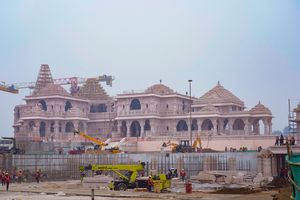On January 22, history will witness the culmination of a nearly 500-year struggle as the consecration of the idol of Shri Ram takes place in Ayodhya. The construction of the Ram Mandir represents not only the physical manifestation of a cherished dream, but also the triumph of justice, marking the end of a protracted legal battle and the fulfilment of the aspirations of countless devotees. As we celebrate this monumental occasion, it is essential to reflect on the significance of this journey.
The Ayodhya dispute has been complex and contentious, and deeply rooted in the country’s history and socioreligious fabric. For a long time, the debate over the birthplace of Lord Ram has fuelled tensions, sparking conflicts that persisted for generations. The protracted legal battle, which finally reached its conclusion in 2019, with the Supreme Court’s unanimous verdict in favour of the construction of the Ram Mandir, stands as a testament to the endurance of India’s judicial system.
The struggle for the Ram Mandir saw the unwavering commitment of countless kar sevaks. Many of them made the ultimate sacrifice, losing their lives in the pursuit of a dream that had been passed down through generations. Their martyrdom exemplifies the resilience and unwavering faith that characterised this struggle.
As we witness the consecration of the idol of Shri Ram, it is fitting to recall the timeless wisdom embedded in the Ramayana, the ancient epic that narrates the life and deeds of Lord Ram. The teachings of the Ramayana transcend religious boundaries and offer profound insights into morality, righteousness and the true essence of dharma. The construction of the Ram Mandir serves as a tangible reminder of these timeless principles.
One of the fundamental teachings of the Ramayana is the concept of dharma—the righteous path that one must follow. Lord Ram, the embodiment of virtue, upheld dharma in every aspect of his life. The consecration of the idol in Ayodhya symbolises the reaffirmation of these timeless values in our society. It is a call to embrace the principles of justice, compassion and integrity that Lord Ram exemplified. It emphasises the importance of aligning oneself with righteousness and duty, embodying the very spirit of the Ram Mandir construction.
The consecration of the idol is not merely the construction of a physical structure; it marks the beginning of a new chapter in India’s history. The Ram Mandir establishes Ram Rajya in the country, an administration system based on principles of dharma.
Dharma denotes behaviours that are considered to be in accord with Rta—the “order and custom” that makes life and universe possible. This includes duties, rights, laws, conduct, virtues and “right way of living”. The concept is believed to have a trans-temporal validity.
In conclusion, the construction of the Ram Mandir stands as a historic moment. It offers a beacon of hope and justice. As we witness this monumental event, let us embrace the teachings of Lord Ram, fostering a society guided by righteousness, compassion and unity. The Ram Mandir is not just a temple; it is a symbol of India’s rich cultural tapestry and the resilience of its people. May it serve as a reminder of the values that define our nation.
Lekhi is Union minister of state for external affairs and culture.


